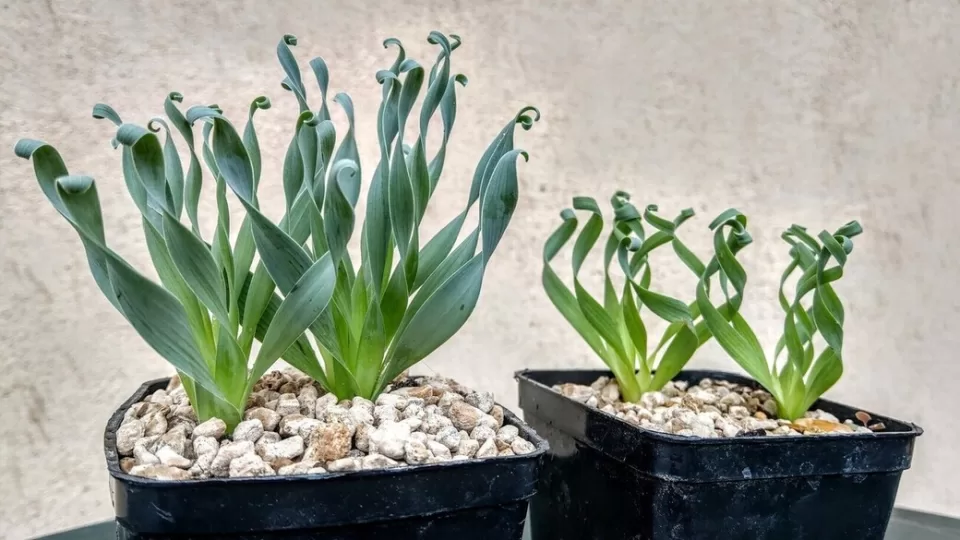Albuca concordiana, commonly known as the Concord Grape Albuca, is a unique and fascinating succulent plant that belongs to the Asparagaceae family.

Native to South Africa, this plant has gained popularity among plant enthusiasts for its distinctive appearance and relatively easy care requirements. In this article, we will explore the essential aspects of Albuca concordiana, including its care, propagation, and flowering.
Care Tips for Albuca Concordiana:
- Light Requirements: Albuca concordiana thrives in bright, indirect light. It is essential to provide the plant with ample sunlight to ensure healthy growth. However, direct exposure to intense sunlight for prolonged periods should be avoided, as it may lead to sunburn.
- Soil and Potting: Plant your Albuca concordiana in well-draining soil. A cactus or succulent mix is ideal, as it prevents waterlogging and promotes aeration of the plant’s roots. Choose a pot with drainage holes to further prevent overwatering.
- Watering: This succulent prefers a regular watering schedule during its growing season in spring and fall. Allow the soil to dry out between waterings, and reduce the frequency during the dormant period in summer. Overwatering can lead to root rot, so it’s crucial to strike a balance.
- Temperature and Humidity: Albuca concordiana does well in warm temperatures and can tolerate a mild frost. However, it is advisable to protect the plant from extreme cold. It adapts well to average indoor humidity levels, making it suitable for a variety of climates.
Propagation of Albuca Concordiana
Albuca concordiana can be propagated through several methods, including offsets and seeds.
- Offsets: The plant produces offsets, or bulbils, around the base. Gently separate these offsets from the main plant, ensuring that each has some roots attached. Plant them in a separate container with well-draining soil, and they should develop into independent plants over time.
- Seeds: Collect seeds from the plant’s seed pods when they mature. Sow the seeds in a well-draining mix and keep them warm and moist until germination occurs. Once the seedlings are large enough, they can be transplanted into individual containers.
Flowering of Albuca Concordiana:
One of the most captivating features of Albuca concordiana is its unique flowering structure. The plant produces tall flower spikes adorned with small, star-shaped flowers that have a striking resemblance to grapes, hence the common name “Concord Grape Albuca.”
Flowering typically occurs in late winter or early spring, adding an extra dimension to the plant’s appeal. To encourage flowering, ensure that the plant receives sufficient light and experiences a period of cool dormancy during the summer months.
Conclusion
Albuca concordiana is an intriguing succulent that can be a delightful addition to any plant collection. By following the recommended care tips, mastering propagation techniques, and understanding the flowering process, plant enthusiasts can enjoy the unique beauty of this remarkable succulent. Whether grown indoors or in a garden setting, the Albuca concordiana is sure to capture the attention of those who appreciate the diversity and charm of succulent plants.
FAQs
Q1: What is Albuca concordiana, and where is it native to?
Albuca concordiana, commonly known as the Concord Grape Albuca, is a succulent plant belonging to the Asparagaceae family. Native to South Africa, it has gained popularity for its unique appearance and is well-regarded among plant enthusiasts.
Q2: How do I care for Albuca concordiana?
- Light: Provide bright, indirect light, avoiding prolonged exposure to intense sunlight.
- Soil and Potting: Plant in well-draining soil, preferably a cactus or succulent mix, in a pot with drainage holes.
- Watering: Water regularly during the growing season, allowing the soil to dry between waterings. Reduce frequency during the dormant period in summer.
- Temperature and Humidity: Thrives in warm temperatures, tolerates mild frost, and adapts well to average indoor humidity levels.
Q3: Can I propagate Albuca concordiana, and if so, how?
Albuca concordiana can be propagated through offsets and seeds.
- Offsets: Gently separate bulbils or offsets from the base of the plant, each with some roots, and plant in a separate container.
- Seeds: Collect mature seeds from the plant’s pods, sow in a well-draining mix, and keep warm and moist until germination. Transplant seedlings when they are large enough.
Q4: When does Albuca concordiana flower, and how can I encourage blooming?
- Flowering Season: Typically, Albuca concordiana flowers in late winter or early spring.
- Encouraging Blooms: Ensure the plant receives sufficient light and experiences a period of cool dormancy during the summer months to promote flowering.
